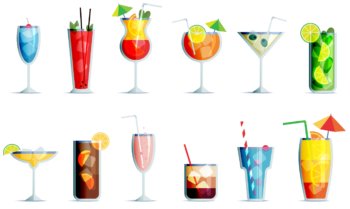What’s Up With Low Alcohol Drinks or No-Alcohol Drinks?
If you’re here at lo2no.com researching low alcohol drinks (or no-alcohol drinks), you’re in the right place. Let’s talk about how low- and no-alcohol beverages differ.

What’s The Difference Between Low- and Non-Alcoholic Beer?
The first thing that you probably think of when you think of low alcohol drinks is probably the classic O’Douls. Since it was first put on the market, people have been buying it in droves. No-alcohol beer, or alcohol-free beer, contains no more than 0.05% ABV. You might wonder, why does alcohol-free beer have any alcohol in it at all? Well, there’s not a lot we can do about it: it’s naturally formed during the brewing process.
Low-alcohol beer contains between 0.5% and 1.2% ABV. Fun fact: an especially ripe banana has an alcohol content of 0.5%! Put simply, three bottles of low-alcohol beer contains about half a “unit” of alcohol, meaning you’d have to drink six or more bottles of low-alcohol beer to ingest the same amount of alcohol in a single measure of vodka.
One reason that many people avoid drinking low alcohol drinks or no-alcohol drinks is because of the taste. But did you know that research shows that most people can’t detect the difference between alcohol-free beer and full-strength beers based solely on taste?

What About No-Alcohol and Low Alcohol Wine?
Many people think that no-alcohol wine is just grape juice, but nothing could be further than the truth! Low- and non-alcoholic wines are made with the same process as full-octane wine. First, grapes are harvested from a vineyard and brought to the winery. Then, they go through the destemming process, followed by a crush in the mechanical press. Just like wine containing alcohol, the grapes might be crushed with or without the skins depending on the type of wine that is being produced.
The difference between grape juice and non-alcoholic wine begins here, with the fermentation process. Grape juice is pasteurized, where non-alcoholic wine goes through the entire fermentation process. Finally, the wine has its alcohol content removed, either through filtration or distillation. This results in a beverage with a flavor profile that is much different from regular grape juice — much more refined than regular old grape juice and definitely worth a try at your next gathering!
The popularity of low- and non-alcoholic drinks is rising quickly among all age groups, from Millennials who want to cut calories to Boomers who are looking for an overall health boost.

Are There Health Benefits to Consuming Non-Alcoholic Drinks?
The popularity of low- and non-alcoholic drinks is rising quickly among all age groups, from Millennials who want to cut calories to Boomers who are looking for an overall health boost. Non-alcoholic drinks are the best choice for those who are completely abstaining from alcohol, whereas low-alcohol drinks will still provide a light effect of alcohol. Which is best for you? That’s a personal decision.
If you’re new to the world of no- and low-alcohol drinks, we’re here to help. At lo2no.com, we’re dedicated to helping you find the best options for low-alcohol drinks, from beers and wines to spirits. If you’re curious about reducing or eliminating your alcohol intake, we can direct you to a beverage you’re sure to enjoy. Check out our reviews of low-alcohol beverages and get started today!



